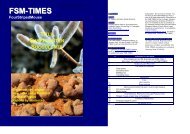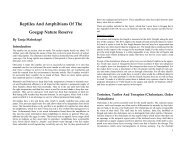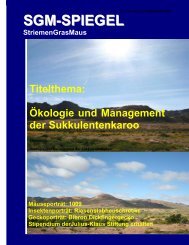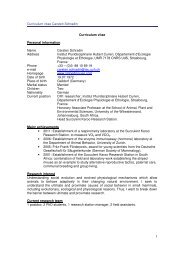SGM-SPIEGEL - Striped Mouse
SGM-SPIEGEL - Striped Mouse
SGM-SPIEGEL - Striped Mouse
Erfolgreiche ePaper selbst erstellen
Machen Sie aus Ihren PDF Publikationen ein blätterbares Flipbook mit unserer einzigartigen Google optimierten e-Paper Software.
prolactin levels, which concurs with studies of cooperatively breeding mammals,<br />
but contrasts with studies in cooperatively breeding birds. Both breeding males<br />
and females showed a decrease in prolactin levels after the breeding season, but<br />
not alloparental philopatric males. Prolactin levels were neither correlated with<br />
corticosterone levels nor with age. These results are in agreement with the<br />
hypothesis that prolactin is one proximate mechanism of male reproductive<br />
tactics, possibly regulating differences in male parental care.<br />
Schradin, C. 2008. Seasonal changes in testosterone and corticosterone<br />
levels in four social categories of a desert dwelling sociable rodent.<br />
Hormone and Behavior 53: 573-579.<br />
Animals have to adjust their physiology to seasonal changes, in response to<br />
variation in food availability, social tactics and reproduction. I compared basal<br />
corticosterone and testosterone levels in free ranging striped mouse from a<br />
desert habitat, comparing between the sexes, breeding and philopatric nonbreeding<br />
individuals, and between the breeding and the non-breeding season. I<br />
expected differences between breeders and non-breeders and between seasons<br />
with high and low food availability. Basal serum corticosterone was measured<br />
from 132 different individuals and serum testosterone from 176 different<br />
individuals of free living striped mice. Corticosterone and testosterone levels<br />
were independent of age, body weight and not influenced by carrying a<br />
transmitter. The levels of corticosterone and testosterone declined by<br />
approximately 50% from the breeding to the non-breeding season in breeding<br />
females as well as non-breeding males and females. In contrast, breeding males<br />
showed much lower corticosterone levels during the breeding season than all<br />
other classes, and were the only class that showed an increase of corticosterone<br />
from the breeding to the non-breeding season. As a result, breeding males had<br />
similar corticosterone levels as other social classes during the non-breeding<br />
season. During the breeding season, breeding males had much higher<br />
testosterone levels than other classes, which decreased significantly from the<br />
breeding to the non-breeding season. My results support the prediction that<br />
corticosterone decreases during periods of low food abundance. Variation in the<br />
pattern of hormonal secretion in striped mice might assist them to cope with<br />
seasonal changes in energy demand in a desert habitat.<br />
Keller, C., and C.Schradin. 2008. Plant and small mammal richness<br />
correlate positively in a biodiversity hotspot. Biodiversity and<br />
Conservation. So far only published online.<br />
Hotspots of biodiversity are important areas in facilitating an understanding of<br />
species richness and its maintenance. Herbivores can increase plant diversity by<br />
reducing dominant plant species thus providing space for subdominant species.<br />
As small mammals are abundant in the Succulent Karoo and therefore might<br />
affect plant diversity by means of herbivory, we tested if this mechanism might<br />
exist in the Succulent Karoo in southern Africa, a biodiversity hotspot due to its<br />
25






